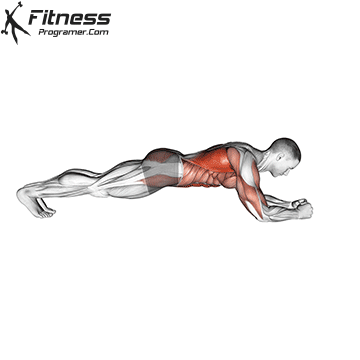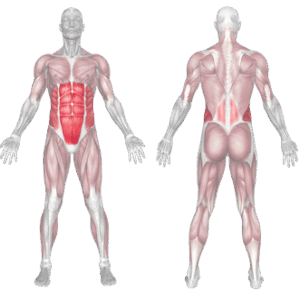Overview
The body saw plank is a dynamic core exercise performed from a forearm plank position. Instead of holding still, you shift your body forward and backward, like a sawing motion. This exercise strengthens the entire core, including deep stabilizers, and demands greater control than the traditional plank. It’s often used in athletic and functional training to improve posture, anti-extension strength, and shoulder stability.
How to perform Body Saw Plank

Start in a forearm plank with your elbows under your shoulders, feet together, and core engaged.
Keep your body in a straight line from head to heels.
Shift your body forward, moving shoulders in front of elbows, keeping core tight.
Saw backward, returning shoulders just behind the elbows, without letting the hips drop.
Continue this controlled forward-backward motion for 30–60 seconds, maintaining full-body tension.
Tips for Proper Form
Engage your glutes and abs to prevent your hips from sagging.
Keep movements small and controlled—no excessive swaying.
Maintain a neutral spine with your head in line with your body.
Push through your toes to initiate the sawing motion.
Focus on quality over speed or range of motion.
Common Mistakes
Letting hips drop during the backward movement, stressing the lower back.
Pushing too far forward, losing tension and form.
Holding your breath, which reduces core engagement.
Shrugging shoulders into the ears instead of keeping scapulae active.
Using momentum rather than core strength to move.
Benefits of the Body Saw Plank
Increases Core Strength: Forces the abdominals and deep core muscles to resist movement dynamically.
Enhances Anti-Extension Control: Trains the body to maintain a rigid spine under shifting load.
Improves Shoulder Stability: Reinforces scapular control and endurance in the shoulder girdle.
Strengthens Deep Stabilizers: Targets the transverse abdominis and obliques more intensely than static planks.
Boosts Athletic Performance: Useful in sports requiring postural endurance, like running, rowing, or combat sports.
Low-Impact, High Activation: Safe for joints when performed correctly, yet very challenging to muscles.
Minimal Equipment Required: Can be done on a towel, sliders, socks, or furniture gliders for smooth motion.
How to Incorporate Into Your Routine
- For Beginners: Start with regular forearm planks and progress to 2–3 sets of 20-second body saws.
- For Core Strength: Perform 3–4 sets of 30–45 seconds with high tension and perfect form.
- For Functional Training: Combine with push-up planks, bird dogs, or loaded carries.
- For General Fitness: Include 2–3 times per week to improve postural control and core activation.
- For Athletic Prep: Use in preseason or sport-specific programming to improve dynamic control.
Body Saw Plank: Muscles Worked

Frequently Asked Questions
What’s the difference between a plank and a body saw?
A plank is static. The body saw adds motion, increasing intensity and core engagement through movement.
What can I use if I don’t have sliders?
Use socks on hardwood, towels on tile, or paper plates on carpet for frictionless movement.
Is this safe for lower back pain?
Only if your form is strict. Avoid it if you can’t maintain a neutral spine or feel discomfort in the lumbar area.
How often should I do body saw planks?
2–3 times a week is ideal for core development, especially as a complement to your other training.
Can I use it in a fat-loss routine?
Yes, it’s excellent for metabolic conditioning when combined with other bodyweight or core drills.
